Popular categories
Looking for a yarn?

100% Alpaca
from 3.40 £ /50g
Order DROPS Needles & Hooks
Clicking the ORDER button will redirect you to Wool Warehouse Direct Ltd website
The yarn cost is calculated from the pattern’s smallest size and the yarn’s cheapest product type. Looking for an even better price? You might find it on the DROPS Deals!
Marelius
DROPS Jacket, trousers, hat and soft toy in Alpaca
Size: 1/3 – 6/9 – 12/18 months (2 – 3/4 years)
Size in cm: 50/56 – 62/68 – 74/80 (86/92 – 98/104)
Materials: DROPS Alpaca from Garnstudio
Jacket:
200-200-200 (250-250) g colour no 100, off-white
DROPS circular needle size 4.5mm
DROPS duffel button, no 520, 4-4-4 (5-5) pcs
Trousers:
100-100-150 (150-150) g colour no 0302, camel
50 g for all sizes colour no 0618, beige-mix
50 g for all sizes colour no 6309, blue-grey
50 g for all sizes colour no 0100, off-white
50 g for all sizes colour no 6205, baby blue
50 g for all sizes colour no 0401, brown
DROPS double pointed and circular needle size 2.5mm and 3mm
Hat:
50 g for all sizes colour no 0302, camel
+ a remnant of colour no 0618, beige-mix
+ remnants from jacket
DROPS double pointed needle size 2.5mm
-------------------------------------------------------
Alternative Yarn – See how to change yarns here
Yarn Groups A to F – Use the same pattern and change the yarn here
Yarn usage using an alternative yarn – Use our yarn converter here
-------------------------------------------------------

100% Alpaca
from 3.40 £ /50g
Order DROPS Needles & Hooks
Clicking the ORDER button will redirect you to Wool Warehouse Direct Ltd website
The yarn cost is calculated from the pattern’s smallest size and the yarn’s cheapest product type. Looking for an even better price? You might find it on the DROPS Deals!
- English (UK/cm)
- Česky - not translated
- Dansk
- Deutsch
- Eesti keel - not translated
- English (US/in)
- Español
- Français
- Íslenska - not translated
- Italiano - not translated
- Magyar
- Nederlands
- Norsk
- Polski
- Português
- Suomi
- Svenska
- English (UK/cm), Bulgaria
- English (UK/cm), Croatia
- English (UK/cm), Greece
- English (UK/cm), Latvia
- English (UK/cm), Lithuania
- English (UK/cm), Romania
- English (UK/cm), Slovenia
- Česky, Slovakia - not translated
Pattern instructions
Knitting tension: 18 sts x 23 rows with 2 strands of Alpaca on needles size 4.5mm in stocking sts = 10 x 10 cm.
Garter sts: Knit all rows
Pattern: See diagram M.1. The diagram shows the pattern from the right side
Buttonhole: Make buttonholes on right front band from mid front as follows: K1, K2 tog, yo, K2. Make buttonholes as follows:
Size 1/3 months: 2, 9, 16 and 22 cm
Size 6/9 months: 3, 10, 17 and 24 cm
Size 12/18 months: 3, 11, 19 and 27 cm
Size 2 years: 3, 10, 17, 24 and 31 cm
Size 3/4 years: 3, 11, 19, 26 and 33 cm
Right front: Knit back and forth on circular needle. Cast on 31-34-40 (42-45) sts (incl 1 edge st at side and 5 front band sts, all knitted in garter sts throughout) with 2 strands of off-white Alpaca and circular needle size 4.5mm. Knit 4 rows garter sts. Knit next row as follows from the right side: 5 front band sts in garter sts, M.1 over the next 24-24-34 (34-34) sts, purl 1-4-0 (2-5) sts and 1 edge st. Continue pattern – remember buttonholes on front band – until piece measures 16-17-20 (23-25) cm. Now cast on new sts at side for sleeve on every other row as follows (incorporate new sts in pattern as you go along):
Size 1/3 months: 2 sts 1 time, 4 sts 1 time, 6 sts 2 times and 15 sts 1 time
Size 6/9 months: 4 sts 2 times, 6 sts 1 time, 8 sts 1 time and 18 sts 1 time
Size 12/18 months: 4 sts 3 times, 6 sts 1 time, 8 sts 1 time and 18 sts 1 time
Size 2 years: 4 sts 2 times, 6 sts 1 time, 8 sts 1 time, 9 sts 1 time and 21 sts 1 time
Size 3/4 years: 4 sts 2 times, 6 sts 1 time, 8 sts 3 times and 21 sts 1 time
After all inc are complete there are 64-74-84 (94-104) sts on row. Continue M.1 with 5 sts in garter sts at sleeve edge and on front band. When piece measures 23-25-28 (32-34) cm put the 9 sts towards mid front on a thread for neck. Now dec to shape the neckline on every other row as follows: 2 sts 1 time and 1 st 2-2-2 (4-4) times = 51-61-71 (79-89) sts left on shoulder/sleeve. When piece measures 27-29-33 (37-40) cm insert a marking thread (= mid shoulder), knit 1 more cm and put piece aside.
Left front: Cast on and knit as right front – do not make buttonholes.
Back piece: Put sts from left front piece on needle, cast on 22-22-22 (26-26) new sts (= back neck), put sts from right front piece on needle = 124-144-164 (184-204) sts. Continue in M.1 with 5 garter sts each side. When piece measures 7-8-8 (9-9) cm from marking thread on shoulder cast off sts on sleeves on every other row as follows:
Size 1/3 months: 15 sts 1 time, 6 sts 2 times, 4 sts 1 time and 2 sts 1 time
Size 6/9 months: 18 sts 1 time, 8 sts 1 time, 6 sts 1 time and 4 sts 2 times
Size 12/18 months: 18 sts 1 time, 8 sts 1 time, 6 sts 1 time and 4 sts 3 times
Size 2 years: 21 sts 1 time, 9 sts 1 time, 8 sts 1 time, 6 sts 1 time and 4 sts 2 times
Size 3/4 years: 21 sts 1 time, 8 sts 3 times, 6 sts 1 time and 4 sts 2 times.
After all dec are complete there are 58-64-76 (80-86) sts left on row. Continue M.1 with 1 edge st each side. When piece measures 26-28-32 (36-39) cm from marking thread knit 4 rows garter sts over all sts and cast off.
Neck: Pick up approx 48 to 58 sts round neck (incl sts on threads on front pieces) with 2 strands off-white and needle size 4.5mm. Knit 3 rows garter sts and cast off.
Assembly: Sew sleeve and side seams within 1 edge st. Sew on buttons.
_________________________________________
TROUSERS:
Knitting tension: 24 sts x 32 rows with 1 strand of Alpaca on needles size 3mm in stocking sts = 10 x 10 cm.
Rib: *K2, P2*, repeat from *-*
Pattern: see diagrams M.2 and M.3.
Decreasing tips (applies to inner side of leg:
Dec as follows 1 st before the marking thread: K2 tog
Decrease as follows 1 st after marking thread: slip 1 st as if to knit, K1, psso.
Start at the top and knit downwards.
Cast on 116-120-124 (132-140) sts with camel and circular needle size 2.5mm. Knit 4 cm Rib. Change to circular needle size 3mm and knit 1 round, at the same time inc evenly on round to 144-156-168 (180-192) sts. Insert a marking thread at the beginning of round = mid back and after 72-78-84 (90-96) sts = mid front.
Knit M.3, at the same time, knitting elevation at the back as follows: knit 12 sts, turn the piece (to avoid a hole slip the first st as if to knit and tighten thread when knitting back), knit 24 sts, turn the piece. Continue like this by knitting 12 sts more before each turn another 8-10-10 (12-12) times. Now knit 1 round over all sts. When piece measures 12-15-16 (17-18) cm (measured from mid front) inc 1 st on each side of the middle 2 sts mid front on every other row a total of 10 times (inc by picking up st from previous row and incorporate this in M.3) = 164-176-188 (200-212) sts. After the last inc the piece measures approx 18-21-22 (23-24) cm mid front. Knit next round as follows from mid back: Cast off 3 sts, knit 76-82-88 (94-100) sts, cast off 6 sts, knit 76-82-88 (94-100) sts, cast off 3 sts. Now finish each leg separately.
Legs: Put sts from one leg on a thread and sts from the other leg on double pointed needles size 3mm = 76-82-88 (94-100) sts. Knit round (continue pattern as before) and insert a marking thread at beginning of round = inner side of leg. When leg measures 2 cm dec 1 st on both sides of marking thread – see Decreasing tips – on every 5-2-3 (2.5-4) cm a total of 2-5-4 (7-6) times = 72-72-80 (80-88) sts. When leg measures 8-11-14 (19-24) cm knit M.2 – start at the top of diagram and knit downwards. After M.2 knit 1 round with camel, at the same time dec evenly to 60-64-68 (72-76) sts. Knit 10 cm Rib and cast off loosely.
Knit the other leg in the same way.
Assembly: Sew opening between legs. Fold the rib at bottom of legs.
_________________________________________
HAT:
Size: 1/3 – 6/18 months (2 –3/4 years)
To fit head circumference: 40/42 – 43/45 (48/50 – 50/52) cm
Knitting tension: 24 sts x 32 rows with 1 strand of Alpaca on needles size 3mm in stocking sts = 10 x 10 cm.
Pattern: see diagrams M.2 and M.3.
Decreasing tips:
Dec as follows before the marking thread: K2 tog
Decrease as follows after marking thread: slip 1 st as if to knit, K1, psso.
Cast on 96-104 (112-120) sts with camel on double pointed needles size 2.5mm and knit 6 cm stocking sts. Now purl 1 round (= folding edge) and knit 1 round. Now knit M.2 once. Change back to camel, knit 1 round and purl 1 round. Now knit M.3, at the same time adjusting number of sts to 96-102 (108-102) on first round. When piece measures 13-15 (16-17) cm from folding edge adjust number of sts to 90-100 (110-120). Now insert 5 marking threads in piece with 18-20 (22-24) sts between each thread. Continue in stocking sts, at the same time dec 1 st on each side of all marking threads on each round until there are 10 sts left – see Decreasing tips. Pull thread through remaining sts and attach. Fold lower edge against wrong side and attach with neat sts – make sure seam isn’t too tight.
Pompon: Make a pompon in camel with a diameter of approx 4 cm and attach at the top of hat.
_________________________________________
SOFT TOY: see pattern no 13-33
Diagram

|
= beige-mix |

|
= off-white |

|
= blue-grey |

|
= baby blue |

|
= brown |

|
= knit from right side, purl from wrong side |

|
= purl from right side, knit from wrong side |

|
= put 2 sts on cable needle behind the piece, K2, K2 from cable needle |

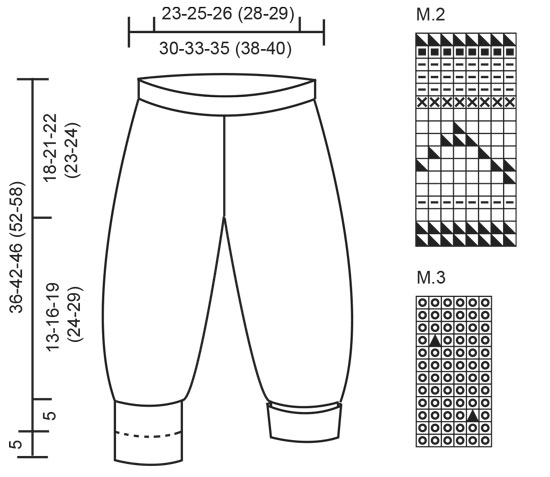
What can you do with our patterns? You can share DROPS patterns online, using the pattern original picture, materials, name and number. But you are NOT ALLOWED to reproduce the complete pattern digitally in any way. Yarn stores are welcome to use the DROPS pattern database to promote the sale of our assortment. You can print out our patterns, make as many copies as you’d like. The only thing we ask is that you don't make any changes / additions to the original printed document. And that the patterns according to the DROPS philosophy are given out to the consumers for free. Editorials that wish to publish our patterns in printed books or magazines can contact us for more information. The sale of garments based on DROPS patterns is permitted as long as they are sold as single items or per order. Further commercial use of the patterns is not permitted. It has to be clearly stated that the garment is made based on a design from DROPS DESIGN. The use of clothing labels of which DROPS DESIGN forms part is conditioned by the inclusion of the following text: “A DROPS DESIGN made by …..”. The use of DROPS photos for marketing purposes/sales is only permitted in connection with the use/sale of DROPS products. The photos may not be cut or edited and the logo should be clearly visible.
We reserve the right to withdraw the permission for use of our patterns at any time, notwithstanding the reason.
Each of our patterns has specific tutorial videos to help you.
These step-by-step tutorials might also help you:
Why is the knitting/crochet tension so important?
Knitting tension is what determines the final measurements of your work, and is usually measured per 10 x 10 cm. It is provided like so: number of stitches in width x number of rows in height - eg: 19 stitches x 26 rows = 10 x 10 cm.
The knitting tension is very individual; some people knit/crochet loosely while others work tightly. You adjust the knitting tension with the needle size, which is why the suggested needle size is only meant as a guide! You need to adjust this (up or down) to ensure that YOUR knitting tension matches the knitting tension provided in the pattern. If you work with a different knitting tension than provided you will have a different yarn consumption, and your work will have different measurements than what the pattern suggests.
The knitting tension also determines which yarns can replace each other. As long as you achieve the same knitting tension you can replace one yarn with another.
See DROPS lesson: How to measure your tension/gauge
See DROPS video: How to make a gauge tension swatch
How do I know how many balls of yarn I need?
The required amount of yarn is provided in grams, eg: 450 g. To calculate how many balls you’ll need you first need to know how many grams are in 1 ball (25g, 50g or 100g). This information is available if you click on the individual yarn quality on our pages. Divide the amount required with the amount of each ball. For example, if each ball is 50g (the most common amount), the calculation will be as follows: 450 / 50 = 9 balls.
Can I use a different yarn than what the pattern suggests?
The important thing when changing from one yarn to another is that the knitting/crochet tension remains the same. This is so that the measurements of the finished piece will be the same as on the sketch provided. It is easier to achieve the same knitting tension using yarns from the same yarn group. It is also possible to work with multiple strands of a thinner yarn to achieve the knitting tension of a thicker one. Please try our yarn converter. We recommend you to always work a test swatch.
Please NOTE: when changing yarn the garment might have a different look and feel to the garment in the photo, due to individual properties and qualities of each yarn.
See DROPS lesson: Can I use a different yarn than the one mentioned in the pattern?
What are the yarn groups?
All our yarns are categorised into yarn groups (from A to F) according to thickness and knitting tension – group A contains the thinnest yarns and group F the thickest. This makes it easier for you to find alternative yarns to our patterns, should you wish to switch yarn. All yarns within the same group have a similar knitting tension and can easily replace each other. However, different yarn qualities have different structures and properties which will give the finished work a unique look and feel.
How do I use the yarn calculator?
At the top of all our patterns you’ll find a link to our yarn calculator, which is a helpful tool should you wish to use a different yarn than suggested. By filling in the yarn quality you wish to replace, the amount (in your size) and number of strands, the calculator will present good alternative yarns with the same knitting tension. Additionally it will tell you how much you’ll require in the new qualities and whether you’ll need to work with multiple strands. Most skeins are 50g (some are 25g or 100g).
If the pattern is worked with multiple colours, every colour will have to be calculated separately. Similarly, if the pattern is worked with several strands of different yarns (for example 1 strand Alpaca and 1 strand Kid-Silk) you will have to find alternatives for each, individually.
Why do you show discontinued yarns in the patterns?
Since different yarns have different qualities and textures we have chosen to keep the original yarn in our patterns. However, you can easily find options among our available qualities by using our yarn calculator, or simply pick a yarn from the same yarn group.
It is possible that some retailers still have discontinued yarns in stock, or that someone has a few skeins at home that they would like to find patterns for.
The yarn calculator will provide both alternative yarn as well as required amount in the new quality.
What size should I knit?
If you think it's hard to decide what size to make, it can be a good idea to measure a garment you own already and like the size of. Then you can pick the size by comparing those measures with the ones available in the pattern's size chart.
You'll find the size chart at the bottom of the pattern.
See DROPS lesson: How to read size chart
Why do I get the wrong knitting tension with the suggested needle size?
The needle size provided in the pattern serves only as a guide, the important thing is to follow the knitting tension. And since knitting tension is very individual, you will have to adjust the needle size to ensure that YOUR tension is the same as in the pattern – maybe you’ll have to adjust 1, or even 2 needle sizes, up or down to achieve the correct tension. For this, we recommend that you work test swatches.
Should you work with a different knitting tension than the one provided, the measurements of the finished garment might deviate from the measurement sketch.
See DROPS lesson: How to measure your tension/gauge
See DROPS video: How to make a tension/gauge swatch
Why is the pattern worked top-down?
Working a garment top-down provides more flexibility and room for personal adjustment. For example it is easier to try the garment on while working, as well as making adjustments to length of yoke and shoulder caps.
The instructions are carefully explaining every step, in the correct order. Diagrams are adjusted to the knitting direction and are worked as usual.
How do I work according to a knitting diagram?
The diagram depicts all rows/rounds, and every stitch seen from the right side. It is read from bottom to top, from right to left. 1 square = 1 stitch.
When working back and forth, every other row is worked from the right side and every other row is worked from the wrong side. When working from the wrong side, the diagram will have to be worked reversed: from left to right, knit stitches are purled, purl stitches are knit etc.
When working in the round every round is worked from the right side and the diagram are worked from right to left on all rounds.
See DROPS lesson: How to read knitting diagrams
How do I work according to a crochet diagram?
The diagram depicts all rows/rounds, and every stitch seen from the right side. It is worked from bottom to top, from right to left.
When working back and forth every other row is worked from the right side: from right to left and every other row is worked from the wrong side: from left to right.
When working in the round, every row in the diagram are worked from the right side, from right to left.
When working a circular diagram you start in the middle and work your way outwards, counter clockwise, row by row.
The rows usually start with a given number of chain stitches (equivalent to the height of the following stitch), this will either be depicted in the diagram or explained in the pattern.
See DROPS lesson: How to read crochet diagrams
How do I work several diagrams simultaneously on the same row/round?
Instructions for working several diagrams after each other on the same row/round, will often be written like so: “work A.1, A.2, A.3 a total of 0-0-2-3-4 times". This means you work A.1 once, then A.2 is worked once, and A.3 is repeated (in width) the number of times provided for your size – in this case like so: S = 0 times, M = 0 times, L=2 times, XL= 3 times and XXL = 4 times.
The diagrams are worked as usual: begin with the first row in A.1, then work the first row in A.2 etc.
See DROPS lesson: How to read knitting diagrams
See DROPS lesson: How to read crochet diagrams
Why are the sleeves shorter in larger sizes?
The total width of the garment (from wrist-to-wrist) will be larger in the larger sizes, despite the actual sleeves being shorter. The larger sizes have longer sleeve caps and wider shoulders, so there will be a good fit in all sizes.
Where on the garment is the length measured?
The measurement sketch/schematic drawing provides information regarding the full length of the garment. If it’s a jumper or a jacket the length is measured from the highest point on the shoulder closest to the neckline, and straight down to the bottom of the garment. It is NOT measured from the tip of shoulder. Similarly, the length of yoke is measured from the highest point on the shoulder and down to where yoke is split into body and sleeves.
On a jacket measures are never taken along bands, unless specifically stated. Always measure inside band stitches when measuring the length.
See DROPS lesson: How to read a schematic drawing
What is a repeat?
Diagrams are often repeated on the round or in height. 1 repeat is the diagram the way it appears in the pattern. If it says to work 5 repeats of A.1 in the round, then you work A.1 a total of 5 times after/next to each other in the round. If it says to work 2 repeats of A.1 vertically/in height you work the entire diagram once, then begin again at the start and work the entire diagram one more time.
Why does the piece start with more chain stitches than it’s worked with?
Chain stitches are slightly narrower than other stitches and to avoid working the cast-on edge too tight, we simply chain more stitches to begin with. The stitch count will be adjusted on the following row to fit the pattern and measurement sketch.
Why increase before the rib edge when the piece is worked top-down?
The rib edge is more elastic and will contract slightly compared to, for example, stocking stitch. By increasing before the rib edge, you avoid a visible difference in width between the rib edge and the rest of the body.
Why increase in the cast-off edge?
It’s very easy to cast off too tightly, and by making yarn overs while casting off (and simultaneously casting these off) you avoid a too tight cast off edge.
See DROPS video: How to bind off with yarn overs (yo)
How do I increase/decrease on every 3rd and 4th row/round alternately?
To achieve an even increase (or decrease) you can increase on, for example: every 3rd and 4th row alternately, like so: work 2 rows and increase on the 3rd row, work 3 rows and increase on the 4th. Repeat this until the increase is complete.
See DROPS lesson: Increase or decrease 1 st on every 3rd and 4th row alternately
How can I work a jacket in the round instead of back and forth?
Should you prefer to work in the round instead of back and forth, you may of course adjust the pattern. You’ll need to add steeks mid-front (usually 5 stitches), and follow the instructions. When you would normally turn and work from the wrong side, simply work across the steek and continue in the round. At the end you’ll cut the piece open, pick up stitches to work bands, and cover the cut edges.
See DROPS video: How to knit steeks and cut open
Can I work a jumper back and forth instead of in the round?
Should you prefer to work back and forth instead of in the round, you may of course adjust the pattern so you work the pieces separately and then assemble them at the end. Divide the stitches for the body in 2, add 1 edge stitch in each side (for sewing) and work the front and back pieces separately.
See DROPS lesson: Can I adapt a pattern for circular needles into straight needles?
Why is the pattern slightly different than what I see in the photo?
Pattern repeats can vary slightly in the different sizes, in order to get the correct proportions. If you’re not working the exact same size as the garment in the photo, yours might deviate slightly. This has been carefully developed and adjusted so that the complete impression of the garment is the same in all sizes.
Make sure to follow instructions and diagrams for your size!
How do I make a women’s size garment into a men’s size one?
If you have found a pattern you like which is available in women’s size it’s not very difficult to convert it to men’s size. The biggest difference will be the length of sleeves and body. Start working on the women size that you think would fit across the chest. The additional length will be worked right before you cast off for the armhole/sleeve cap. If the pattern is worked top-down you can add the length right after the armhole or before the first decrease on sleeve.
Regarding additional yarn amount, this will depend on how much length you add, but it is better with a skein too many than too few.
How do I prevent a hairy garment from shedding?
All yarns will have excess fibres (from production) that might come off as lint or shedding. Brushed yarns (ie hairier yarns) have more of these loose, excess fibres, causing more shedding.
Shedding also depends on what is worn under or over the garment, and whether this pulls at the yarn fibres. It’s therefore not possible to guarantee that there will be no shedding
Below are some tips on how to get the best result when working with hairier yarns:
1. When the garment is finished (before you wash it) shake it vigorously so the looser hairs come off. NOTE: do NOT use a lint roller, brush or any method that pulls at the yarn.
2. Place the garment in a plastic bag and put it in your freezer - the temperature will cause the fibres to become less attached to each other, and excess fibres will come off easier.
3. Leave in the freezer for a few hours before taking it out and shaking it again.
4. Wash the garment according to the instructions on the yarn label.
Why does my garment pill?
Pilling is a natural process that happens to even the most exclusive of fibers. It's a natural sign of wear and tear that is hard to avoid, and that is most visible in high friction areas of your garment like a sweater's arms and cuffs.
You can make your garment look as new by removing the pilling, using a fabric comb or a pill/lint remover.
In the meantime, you can read the questions and answers that others have left to this pattern or join the DROPS Workshop on Facebook to get help from fellow knitters/crocheters!
You might also like...
Marelius |
|||||||||||||||||||||||||
 |
 |
||||||||||||||||||||||||
DROPS Jacket, trousers, hat and soft toy in Alpaca
DROPS Baby 13-14 |
|||||||||||||||||||||||||
|
JACKET: Knitting tension: 18 sts x 23 rows with 2 strands of Alpaca on needles size 4.5mm in stocking sts = 10 x 10 cm. Garter sts: Knit all rows Pattern: See diagram M.1. The diagram shows the pattern from the right side Buttonhole: Make buttonholes on right front band from mid front as follows: K1, K2 tog, yo, K2. Make buttonholes as follows: Size 1/3 months: 2, 9, 16 and 22 cm Size 6/9 months: 3, 10, 17 and 24 cm Size 12/18 months: 3, 11, 19 and 27 cm Size 2 years: 3, 10, 17, 24 and 31 cm Size 3/4 years: 3, 11, 19, 26 and 33 cm Right front: Knit back and forth on circular needle. Cast on 31-34-40 (42-45) sts (incl 1 edge st at side and 5 front band sts, all knitted in garter sts throughout) with 2 strands of off-white Alpaca and circular needle size 4.5mm. Knit 4 rows garter sts. Knit next row as follows from the right side: 5 front band sts in garter sts, M.1 over the next 24-24-34 (34-34) sts, purl 1-4-0 (2-5) sts and 1 edge st. Continue pattern – remember buttonholes on front band – until piece measures 16-17-20 (23-25) cm. Now cast on new sts at side for sleeve on every other row as follows (incorporate new sts in pattern as you go along): Size 1/3 months: 2 sts 1 time, 4 sts 1 time, 6 sts 2 times and 15 sts 1 time Size 6/9 months: 4 sts 2 times, 6 sts 1 time, 8 sts 1 time and 18 sts 1 time Size 12/18 months: 4 sts 3 times, 6 sts 1 time, 8 sts 1 time and 18 sts 1 time Size 2 years: 4 sts 2 times, 6 sts 1 time, 8 sts 1 time, 9 sts 1 time and 21 sts 1 time Size 3/4 years: 4 sts 2 times, 6 sts 1 time, 8 sts 3 times and 21 sts 1 time After all inc are complete there are 64-74-84 (94-104) sts on row. Continue M.1 with 5 sts in garter sts at sleeve edge and on front band. When piece measures 23-25-28 (32-34) cm put the 9 sts towards mid front on a thread for neck. Now dec to shape the neckline on every other row as follows: 2 sts 1 time and 1 st 2-2-2 (4-4) times = 51-61-71 (79-89) sts left on shoulder/sleeve. When piece measures 27-29-33 (37-40) cm insert a marking thread (= mid shoulder), knit 1 more cm and put piece aside. Left front: Cast on and knit as right front – do not make buttonholes. Back piece: Put sts from left front piece on needle, cast on 22-22-22 (26-26) new sts (= back neck), put sts from right front piece on needle = 124-144-164 (184-204) sts. Continue in M.1 with 5 garter sts each side. When piece measures 7-8-8 (9-9) cm from marking thread on shoulder cast off sts on sleeves on every other row as follows: Size 1/3 months: 15 sts 1 time, 6 sts 2 times, 4 sts 1 time and 2 sts 1 time Size 6/9 months: 18 sts 1 time, 8 sts 1 time, 6 sts 1 time and 4 sts 2 times Size 12/18 months: 18 sts 1 time, 8 sts 1 time, 6 sts 1 time and 4 sts 3 times Size 2 years: 21 sts 1 time, 9 sts 1 time, 8 sts 1 time, 6 sts 1 time and 4 sts 2 times Size 3/4 years: 21 sts 1 time, 8 sts 3 times, 6 sts 1 time and 4 sts 2 times. After all dec are complete there are 58-64-76 (80-86) sts left on row. Continue M.1 with 1 edge st each side. When piece measures 26-28-32 (36-39) cm from marking thread knit 4 rows garter sts over all sts and cast off. Neck: Pick up approx 48 to 58 sts round neck (incl sts on threads on front pieces) with 2 strands off-white and needle size 4.5mm. Knit 3 rows garter sts and cast off. Assembly: Sew sleeve and side seams within 1 edge st. Sew on buttons. _________________________________________ TROUSERS: Knitting tension: 24 sts x 32 rows with 1 strand of Alpaca on needles size 3mm in stocking sts = 10 x 10 cm. Rib: *K2, P2*, repeat from *-* Pattern: see diagrams M.2 and M.3. Decreasing tips (applies to inner side of leg: Dec as follows 1 st before the marking thread: K2 tog Decrease as follows 1 st after marking thread: slip 1 st as if to knit, K1, psso. Start at the top and knit downwards. Cast on 116-120-124 (132-140) sts with camel and circular needle size 2.5mm. Knit 4 cm Rib. Change to circular needle size 3mm and knit 1 round, at the same time inc evenly on round to 144-156-168 (180-192) sts. Insert a marking thread at the beginning of round = mid back and after 72-78-84 (90-96) sts = mid front. Knit M.3, at the same time, knitting elevation at the back as follows: knit 12 sts, turn the piece (to avoid a hole slip the first st as if to knit and tighten thread when knitting back), knit 24 sts, turn the piece. Continue like this by knitting 12 sts more before each turn another 8-10-10 (12-12) times. Now knit 1 round over all sts. When piece measures 12-15-16 (17-18) cm (measured from mid front) inc 1 st on each side of the middle 2 sts mid front on every other row a total of 10 times (inc by picking up st from previous row and incorporate this in M.3) = 164-176-188 (200-212) sts. After the last inc the piece measures approx 18-21-22 (23-24) cm mid front. Knit next round as follows from mid back: Cast off 3 sts, knit 76-82-88 (94-100) sts, cast off 6 sts, knit 76-82-88 (94-100) sts, cast off 3 sts. Now finish each leg separately. Legs: Put sts from one leg on a thread and sts from the other leg on double pointed needles size 3mm = 76-82-88 (94-100) sts. Knit round (continue pattern as before) and insert a marking thread at beginning of round = inner side of leg. When leg measures 2 cm dec 1 st on both sides of marking thread – see Decreasing tips – on every 5-2-3 (2.5-4) cm a total of 2-5-4 (7-6) times = 72-72-80 (80-88) sts. When leg measures 8-11-14 (19-24) cm knit M.2 – start at the top of diagram and knit downwards. After M.2 knit 1 round with camel, at the same time dec evenly to 60-64-68 (72-76) sts. Knit 10 cm Rib and cast off loosely. Knit the other leg in the same way. Assembly: Sew opening between legs. Fold the rib at bottom of legs. _________________________________________ HAT: Size: 1/3 – 6/18 months (2 –3/4 years) To fit head circumference: 40/42 – 43/45 (48/50 – 50/52) cm Knitting tension: 24 sts x 32 rows with 1 strand of Alpaca on needles size 3mm in stocking sts = 10 x 10 cm. Pattern: see diagrams M.2 and M.3. Decreasing tips: Dec as follows before the marking thread: K2 tog Decrease as follows after marking thread: slip 1 st as if to knit, K1, psso. Cast on 96-104 (112-120) sts with camel on double pointed needles size 2.5mm and knit 6 cm stocking sts. Now purl 1 round (= folding edge) and knit 1 round. Now knit M.2 once. Change back to camel, knit 1 round and purl 1 round. Now knit M.3, at the same time adjusting number of sts to 96-102 (108-102) on first round. When piece measures 13-15 (16-17) cm from folding edge adjust number of sts to 90-100 (110-120). Now insert 5 marking threads in piece with 18-20 (22-24) sts between each thread. Continue in stocking sts, at the same time dec 1 st on each side of all marking threads on each round until there are 10 sts left – see Decreasing tips. Pull thread through remaining sts and attach. Fold lower edge against wrong side and attach with neat sts – make sure seam isn’t too tight. Pompon: Make a pompon in camel with a diameter of approx 4 cm and attach at the top of hat. _________________________________________ SOFT TOY: see pattern no 13-33 |
|||||||||||||||||||||||||
Diagram explanations |
|||||||||||||||||||||||||
|
|||||||||||||||||||||||||

|
|||||||||||||||||||||||||

|
|||||||||||||||||||||||||
|
Have you made this or any other of our designs? Tag your pictures in social media with #dropsdesign so we can see them! Do you need help with this pattern?You'll find tutorial videos, a Comments/Questions area and more by visiting the pattern on garnstudio.com. © 1982-2024 DROPS Design A/S. We reserve all rights. This document, including all its sub-sections, has copyrights. Read more about what you can do with our patterns at the bottom of each pattern on our site. |
|||||||||||||||||||||||||
With over 40 years in knitting and crochet design, DROPS Design offers one of the most extensive collections of free patterns on the internet - translated to 17 languages. As of today we count 304 catalogues and 11422 patterns - 11422 of which are translated into English (UK/cm).
We work hard to bring you the best knitting and crochet have to offer, inspiration and advice as well as great quality yarns at incredible prices! Would you like to use our patterns for other than personal use? You can read what you are allowed to do in the Copyright text at the bottom of all our patterns. Happy crafting!







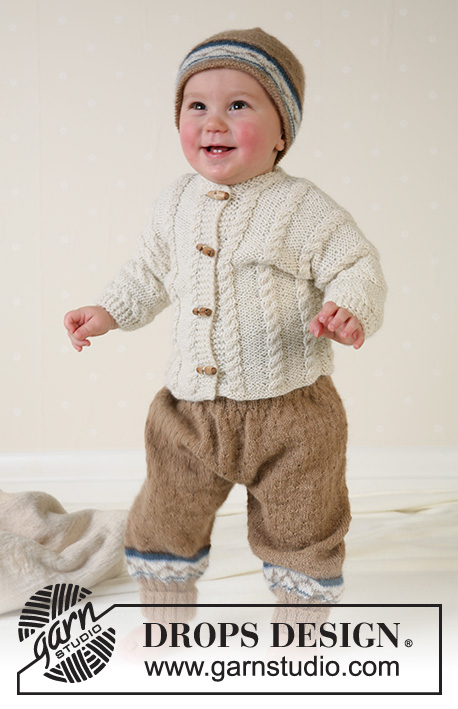
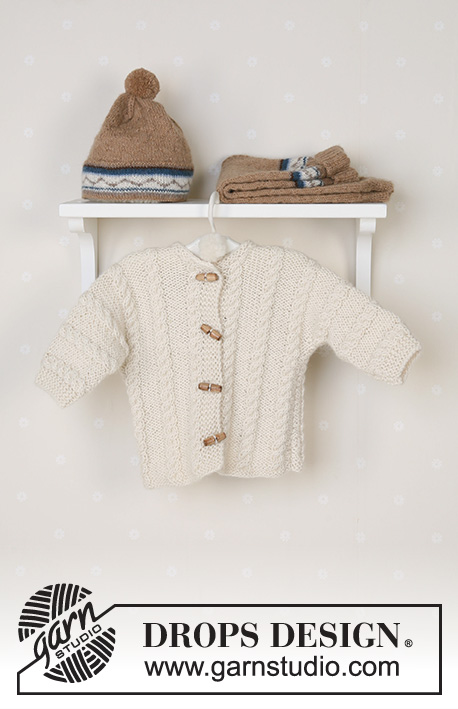

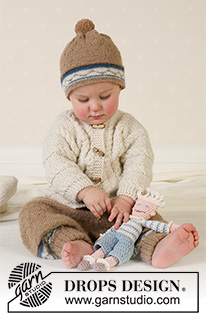
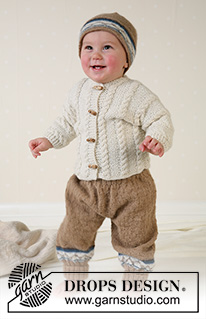
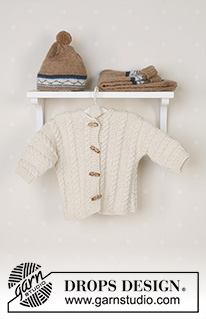







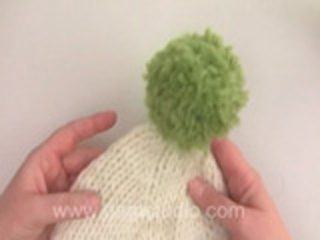















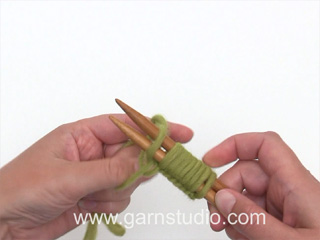
























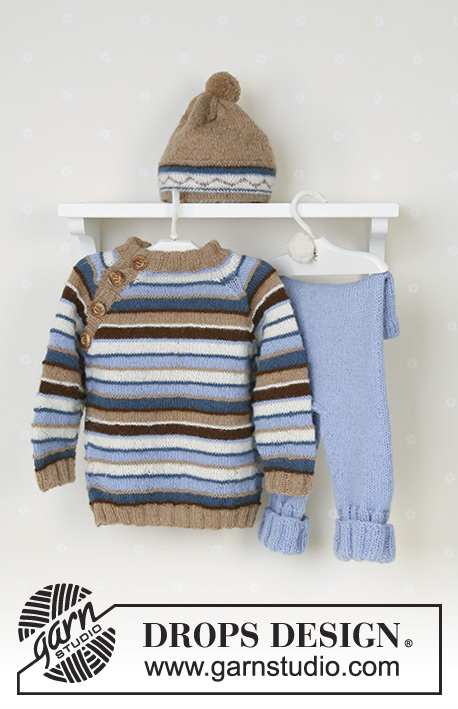








Comments / Questions (15)
Når beinet måler 24cm. Menes det ifra livet eller mellom bein.
19.03.2023 - 21:28DROPS Design answered:
Hei Christina, Beinet er målt mellom beinene. God fornøyelse!
20.03.2023 - 06:49Tusen takk for raskt svar
17.03.2023 - 09:46Skal det virkelig snus 12 ganger til forhøyning bak på buksen? Eller er det 6 ganger på hver siden av mm
16.03.2023 - 22:02DROPS Design answered:
Hej Cristina, det er ialt du snur 12 gange, så det bliver 6 gange i hver side :)
17.03.2023 - 09:03Bonjour, il y a toujours une erreur sur la patron Français en 12-18 mois, sur le devant, la dernière augmentation pour faire les manches est de 18 mailles et non de 21. cordialement.
06.09.2022 - 11:20DROPS Design answered:
Bonjour Mme Poulet et merci, la correction a été corrigée :) Bonne continuation!
06.09.2022 - 12:06Les augmentations devant en 12-18 mois ne sont pas identiques aux diminutions dos
21.08.2022 - 20:35DROPS Design answered:
Bonjour Mme Poulet, les diminutions du dos sont correctes, ce sont celles du devant qui étaient erronées, il faut bien augmenter 3 fois 4 mailles au début (et non 2 fois seulement). Merci pour votre retour, la correction a été faite. Bon tricot!
22.08.2022 - 10:17Vraag: wordt het vestje helemaal met 2 draden gebreid? groet Bea
01.02.2022 - 19:25Bij het rugpand voor het minderen van de mouw staat 1x4 st maar met opzetten staat dit er niet dus of het is daar vergeten of het staat bij het minderen verkeerd. Ik denk ij het laatste omdat het patroon klopt zonder die 4 steken.
09.01.2022 - 15:54Hej! Enligt mönstret ska tröjan stickas med ”två trådar natur”. Vad betyder det? Ska tröjan stickas med dubbelt garn?
22.04.2021 - 23:04DROPS Design answered:
Hej Gunilla. Ja det stämmer, tröjan stickas med dubbelt garn. Mvh DROPS Design
23.04.2021 - 10:59Bij het vestje staat in het rechter voorpand Zet bij ( )CM de 9 steken van de middenvoor op een hulp draad. Welke 9 steken?
24.11.2020 - 11:26DROPS Design answered:
Dag Sylvia,
Daarmee worden de eerste 9 steken op de naald aan de kant van de knoopbies bedoeld.
24.11.2020 - 13:23Hallo liebes Drops-Team, Ich komme einfach nicht dahinter, wir im Diagramm M3, Re von rechts, li von links und li von rechts, Re von links zu stricken ist. Könnt ihr mir da bitte helfen? Vielen Dank für die Mühe und herzliche Grüße Tina
13.11.2019 - 18:39DROPS Design answered:
Liebe Tina, bei der Erhöhung wird M.3 in Hin- und Rückreihen gestrickt (bei Hinreihen lesen Sie M.3 rechts nach links und bei Rückreihen lesen Sie M.3 links nach rechts). Wenn Sie dann wieder in Runden stricken, lesen Sie M.3 immer rechts nach links (= Hinreihen). M.3 wird glatt rechts gestrickt (= 6. Symbol) mit linken Maschen (= 7.Symbol) - von der Vorderseite gesehen. Viel Spaß beim stricken!
14.11.2019 - 09:31